For the entertainment of children on the street, they choose a place that is remote and fenced off from highways. The playground is for sports or for the games of preschool children. There are building standards, safety, recommendations for the use of special materials. Requirements for facilities are spelled out in GOST R 52.169. 2003. The document regulates the types of equipment, contains a list of tests for swings, slides, and other play equipment.
Site location selection
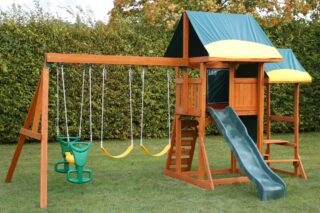
The area of children's entertainment is removed from motor roads, since a large volume of exhaust gases and toxic products accumulates in the area of the tracks. Car owners violate parking rules in the multi-apartment sector, so they put up a fence to prevent vehicles from parking on the site.
The standard layout rules are taken into account:
- Set up an entertainment space away from dumpsters. Pay attention to the prevailing wind direction so that bags, plastic do not spread towards children. Take into account the location of the passage to the tanks, where the cleaning car will go.
- You can not occupy the area where dogs are walking, where dog lovers are used to gathering. Pets can cause illness in children.
The fence is needed to protect against teenage vandalism, especially in the evening and at night. It is good to equip benches with a table nearby in the courtyard so that adults do not have a desire to use the playground. It comes at a cost, but restoring children's facilities is sometimes more expensive.
Safety requirements
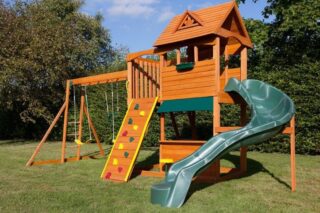
The equipment must comply with the general requirements, as well as obey the construction rules according to the instructions of the document GOST R ISO / IEC 50 and GOST ISO / TO 12.100.2.
A playground for a summer cottage, a private house, a suburban area is being built taking into account the requirements:
- compliance with a group of children according to the age for which they are predetermined;
- the ability of adults to access inside small houses, on top of the slides, to provide assistance;
- no accumulation of moisture and water on horizontal surfaces, ensuring drainage and drying.
Structures must be rigid, durable, stable, not change in space. Object parts are made of materials that are resistant to corrosion, such as wood. Metal is protected against corrosion by painting. Elements made of composite materials, polymers reduce the bearing capacity over time, become brittle, so they are changed in a timely manner.
Covering for playgrounds
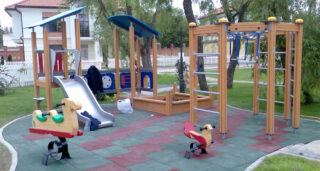
Design materials should not harm health and the environment during use. The layer is made so that it is heated by the sun's rays and does not cause burns when touched.
The option must be safe, not conducive to injury:
- sand is applied with a thickness of 15 cm for small children, from 30 cm it is laid for schoolchildren;
- wooden boardwalk is considered not rigid, the material is suitable for arranging the site, its lack of fragility and rotting from moisture;
- fine gravel (up to 0.5 mm) will be soft, granules of this size will not scratch the skin of babies;
- modern tiles made of rubberized materials bounce when children fall, do not require special care, washable with a jet from a hose.
They do not use flammable materials, such as polymers, as well as species that emit toxic poisonous gases when burned. Do not trim the play area with types of coverage that have not been studied.
For the materials used, the manufacturer indicates the service life and technical characteristics.
Requirements for the smoothness of surfaces and the absence of sharp corners
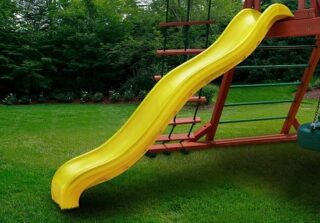
Sharp edges of parts, protruding corners, ends, edges, and other elements of site equipment are dangerous. On rough surfaces, a child can injure the skin if rubbed or dropped.
Primary requirements:
- parts of slides, stairs, swings, houses are made with rounded edges and edges, regardless of whether they are wooden or iron;
- surfaces vertically and horizontally are carefully polished, peeling layers are removed, treated with emery or a grinding wheel;
- the ends of the bolts protruding from under the nut are cut off, ground;
- the value of the angle between the vertical surfaces of the V-shaped slots and gaps is not allowed less than 60 °;
- welded seams are cleaned of scale and grinded with a grinder;
- parts are fixed so that they cannot be removed manually, but only with the use of a tool.
Moving parts such as rollers and bearings are protected from access by a rigid housing. Parts of the objects of the children's complex should not contribute to the stuck of the child, form squeezing conditions.
Recommended area
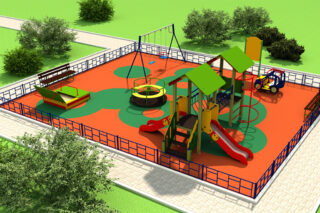
The dimensions of the play yard complex are made according to the age of the children, taking into account the area of the residential building next to the site.
Standard planning indicators:
- as a standard, they make a project for one visitor of the site 0.5 - 0.7 m²;
- for preschoolers, a plot with a square of 55 - 75 m² (minimum value) is sufficient, the optimal area is 75 - 140 m²;
- schoolchildren will actively play on a playground of 100 - 300 m2, while the size of the complex zone will be 850 - 1500 m2;
- if the play area for preschoolers is combined with an adult recreation area, they count on a square of 150 m².
The playground should have a play area, a safety area and a landing strip. The first square is represented by places with equipment where a child plays. The second area provides an environment of movable objects, where the baby rolls down the slide, swings on the swing. The third zone provides a place where the child is braked, where he can stop after falling.
Children's playground project
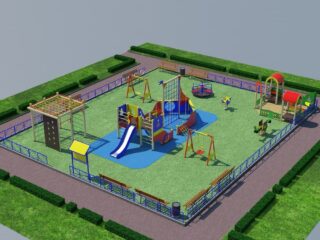
To design the play area of an apartment building, the city administration attracts architects, designers, design specialists, engineers who present sketches and models, and advocate new ideas. In a private house for 1 - 3 children, you can build a homemade playground using simple improvised means.
The designers take into account the number of children simultaneously at the play facility and calculate the load. They take the maximum value with a small margin of safety. Any piece of equipment for lifting, standing, walking more than 10 cm wide with an incline of up to 30 ° must support one child.
The decorative solution takes into account the exterior of the surrounding buildings and the landscape. Complexes for children are painted in bright and rich colors.
The main objects of playgrounds
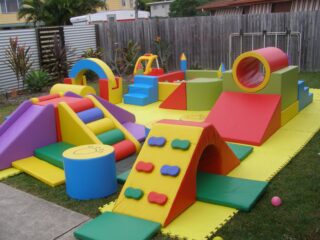
The outdoor play complex contains equipment that develops children mentally and physically. Structural structures provide a meaningful pastime.
The list of objects includes play equipment, depending on the division by age:
- Children's playground for toddlers 3 - 6 years old. They arrange passages, sandboxes, bridges, small swings, build houses, rocking chairs.
- Playground for schoolchildren 7 - 16 years old. Mounting walls for climbing, climbing, cable cars and nets, slides with a complex descent trajectory, horizontal bars and exercise ladders.
- A versatile building for all ages. The playground has large and small swings, spinning carousels, sandboxes and other objects for different ages.
Site objects are appropriate for height, weight, physical characteristics and capabilities. When placing, the degree of illumination of individual areas is taken into account.
Sandboxes
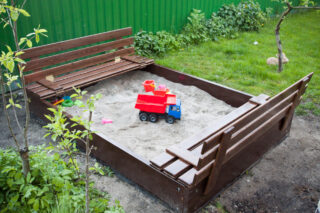
In them, young children play with sand and appropriate toys. The structure is fenced with a side so that the sand does not spread around. The frame is made of wood, metal. Small ready-made models are made from plastic in production, they are purchased in a store, installed in the yard.
Sandboxes of types:
- buried, when soil is removed for the body of the structure, while the sand is at ground level;
- surface - the sides are above the soil surface, this option requires the preparation of a concrete or plank base.
Sandboxes are made in the form of houses, ships, rockets, cars. The cover is removable or foldable in the seat for ease of play. Closed models prevent clogging with foliage, animal excrement.
Children's houses
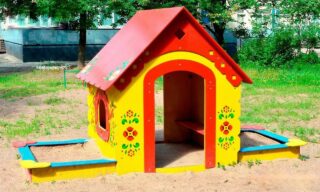
Preschoolers and schoolchildren are happy to spend time in cozy buildings in the form of a house in the children's area. The style for the construction is different. They use design solutions in the form of an Indian hut, a palace from a fairy tale, a chalet. Structures in the form of a rocket and an airplane are popular.
Houses protect children from the scorching sun, shelter from rain and snow. The material is wood, metal, plastic. Buildings are made as open as possible, windows are provided in all walls. Houses come with one door or they are made with walk-throughs.
The roof is covered with boards, corrugated board, metal tiles, while a protective strip of wood and plastic is made along the edge of the material. There may be a floor inside, or children are playing on the ground. For the base, take boards, gravel bedding, sand.
Slides for children
Structures are made of metal, which is painted, soft wood, durable plastic. Slides are sometimes made in combination with crossings, upper fenced areas, built-on houses. Straight stairs lead to the object, or they are built with several turns. The steps are almost always made of wood, the edges of which are rounded.
The frame must be stable and strong, often several people gather at the top of the slide. On the stairs, passages and platforms, a handrail must be arranged for safety. The surface for the descent is made of smooth materials, more often they put stainless steel sheets or polished hard wood. Place the slides so that there is a place in front for the baby to stop after rolling.
Swing
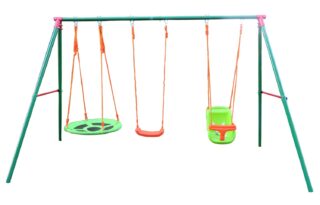
The supporting frame is made of a metal profile, wooden bars. The seat for little ones is made with a lowering body lock. The seat is attached to the beam with cables, steel profiles, thick ropes, chains.
They belong to the traumatic objects of the children's complex, therefore, special requirements are imposed on them:
- there must be enough room for swinging around so as not to injure the children in front;
- between the frame pillars and the seat line of motion provide for a gap of 20 cm;
- for attaching suspensions to the saddle and beam, standard, specially developed methods are used.
On large swings, swing clamps are installed so that the seat does not roll over in the air. Prevent ropes or cables from twisting when swinging to make the playground safe.
Ladders and hanging paths
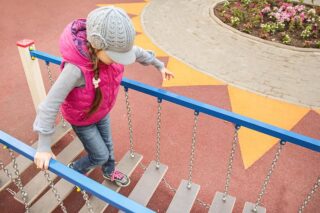
The height of the handrail is no less than 600 and no more than 800 mm from the running surface (schoolchildren), no higher than 600 mm (preschoolers). Fences are designed so that the child does not have the desire to climb and sit on them. The material is iron, it is welded or bolted together. Handrails are made of wood; they are fixed to the railing frame with bolts, nuts and washers.
Ladders can be steep or inclined; they provide their own option for each age group. The steps are made horizontal, the deviation is allowed at 3 °. There should be no gaps between adjacent treads when viewed from above.
Suspended tracks are made of separate elements that can communicate with each other or be in free movement. Such elements are made massive so that they do not move too much under the weight of children. Use rounded logs, chains with welded links.








